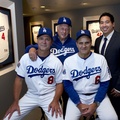In a recent interview, Dr. ShiPu Wang discussed the lengthy process and inspiration for curating the exhibition titled Pictures of Belonging: Miki Hayakawa, Hisako Hibi, and Miné Okubo and the exhibition’s complementing catalog.
The lengthy process began nearly 20 years ago when he was writing his dissertation to obtain a PhD from the University of California, Santa Barbara. His dissertation, Becoming American? Asian Identity Negotiated Through the Art of Yasuo Kuniyoshi, proved to be a complicated task as there was very little information available about Asian American artists of the pre-World War II generations. As a result, he would dedicate his career to “rediscover[ing] as many Asian American artists as possible.”
Dr. Wang has authored three books focusing on Japanese American artists’ works: Becoming American? Asian Identity Negotiated Through the Art of Yasuo Kuniyoshi and The Other American Moderns: Matsura, Ishigaki, Noda, Hayakawa and Chiura Obata: An American Modern. He continues to rediscover an array of talented Japanese American artists whose work have either been forgotten or unknown to the general American public. His latest endeavor, Pictures of Belonging, continues that trend by focusing on the artwork and lives of three trailblazing Japanese American female artists whose careers all began prior to World War II.
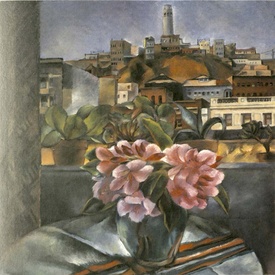
According to Dr. Wang, Pictures of Belonging hopes to “(re)introduce the three artists [to the public] by allowing the viewer to appreciate and learn about these artists’ work and to reflect on what (and who) defined American art in specific historical moments, while considering reasons for their omission from accounts of twentieth-century art in the United States.”1 Additionally, Pictures of Belonging looks at the unique gender and racial biases that these three artists faced throughout their careers.
The catalog accomplishes this by providing readers with a sampling of more than 160 images that showcase each artists’ body of work and a variety of essays written by Dr. ShiPu Wang, author, Coats Family Chair in the Arts and professor of art history at the University of California, Merced; Becky Alexander, archivist at the San Francisco Art Institute Legacy Foundation and Archive; Dr. Cécile Whiting, professor emerita and Chancellor’s Professor of Art History at the University of California, Irvine; Patricia Wakida, associate editor of the Densho Encyclopedia project and contributing editor to the Discover Nikkei website; Rihoko Ueno, archivist at the Archives of American Art, Smithsonian Institution; and Melissa Ho, curator of 20th-century art at the Smithsonian American Art Museum.
Their essays examine the artists’ lives and art careers prior to the United States entrance into World War II, during World War II/Japanese incarceration, and after World War II.
Pre-World War II
The essays written by Dr. ShiPu Wang and Becky Alexander examine the lives of each artist and the interconnections that they had with each other while living in San Francisco. Both Hibi and Hayakawa attended the California School of Fine Arts, while Okubo attended the University of California, Berkeley and was an active member of the San Francisco Art Association.2
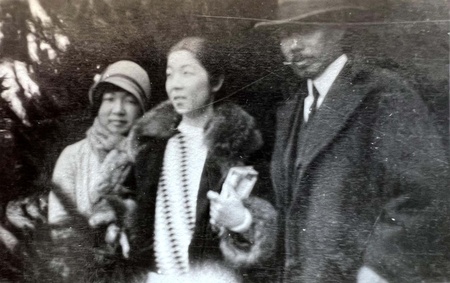
According to Alexander, “For artists of Asian descent living and working in San Francisco, the 1920s and 1930s offered unprecedented opportunities for professional recognition within a receptive art community, despite the larger context of widespread racism and progressively draconian anti-Asian/anti-immigration laws.”3
Each artist would develop their own unique style and use a variety of art mediums to depict themes and people that were relevant to each of their lives. According to Dr. Wang, “[The] personal and emotional connections compelled Okubo, Hibi, and Hayakawa to create portraits that represented their intimate moments with and memories of their loved ones, their friends, and people they encountered.”4
World War II/Japanese Incarceration

The bombing of Pearl Harbor and the United States entrance into World War II would displace all three artists. Hayakawa relocated to Santa Fe, New Mexico and abandoned her Northern California residence of three decades. Meanwhile, Hibi and Okubo were both incarcerated at Tanforan Assembly Center and later Topaz War Relocation Center.5
While all three artists continued to produce art and submit their artwork to exhibitions, the subject matter presented by Hibi and Okubo depicted the harsh living conditions and scenes of Topaz War Relocation Center’s desert environment. Despite the unfavorable living conditions, both share their knowledge of art with other inmates by teaching at Tanforan Assembly Center (Okubo) and Topaz War Relocation Center (Hibi).6

Post-World War II
After the war, all three artists continued their passion for art. Hayakawa, the oldest of the three, remained in Santa Fe and continued to showcase her work at numerous local exhibitions.7
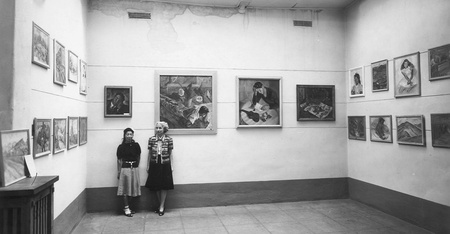
Okubo moved to New York where she earned a living off of commissions by creating illustrations for books and periodicals.8 She also authored her own graphic novel, Citizen 13660, which depicted her incarceration experience at Topaz War Relocation Center and the book was entered into congressional records when she testified to the United States Congress’ Commission on Wartime Relocation and Internment of Civilians in 1983.9
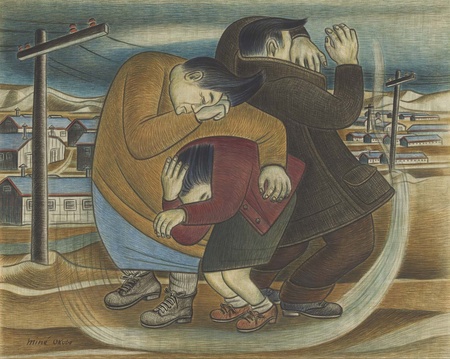
Hibi also moved to New York and worked as a seamstress in the garment industry to support her two children due to the untimely death of her husband, artist Matsusaburo George Hibi, in 1947.10 She eventually moved back to San Francisco in 1954 and began to experiment with abstract stylized paintings.11
While in San Francisco, she received numerous honors for her lifetime career in art, including a United States congressional tribute from Representative Robert T. Matsui for her work with the San Francisco Women Artists Association; a commendation from the Arts Commission of San Francisco; and a declaration of June 14th as “Hisako Hibi Day” by then-Mayor Dianne Feinstein.12
Pictures of Belonging Touring Exhibition
Despite each of these artists’ contributions to both the art world and society, much of their artwork and achievements remain unknown or forgotten. As a result, the touring exhibition hopes to “(re)introduce the three artists by bringing representative works from each together for the first time.”

The exhibition will feature more than 80 paintings and sketches and visit 5 cities: Salt Lake City, Utah (February 24, 2024–June 30, 2024); Washington, DC (November 15, 2024–August 17, 2025); Philadelphia, Pennsylvania (October 2, 2025–January 4, 2026); Monterey, California (February 5, 2026–April 19, 2026); and Los Angeles, California (late 2026).
Its first stop, the Utah Museum of Fine Arts in Salt Lake City, holds special meaning as both Hibi and Okubo were incarcerated in Utah during World War II. The exhibition then travels to one of the United States most respected museums, the Smithsonian American Art Museum, and then to what is considered America’s first art school and museum, the Pennsylvania Academy of the Fine Arts, which will allow these artists to be seen by a broader audience. Next, it makes a homecoming of sorts to the Monterey Museum of Art in Northern California, where all three artists spent a significant amount of their lives both living and partaking in nearby San Francisco’s art community. Lastly, the tour concludes with a visit to the Japanese American National Museum, which, according to Dr. Wang, “had unwavering belief in this project.”
Notes:
1. ShiPu Wang, ShiPu. “Introduction: Pictures of Belonging,” in Pictures of Belonging: Miki Hayakawa, Hisako Hibi, and Miné Okubo. Edited by ShiPu Wang, 14. Los Angeles, CA: Japanese American National Museum. 2023.
2. Becky Alexander, “The California School of Fine Arts in Interwar San Francisco,” in Pictures of Belonging, 60.
3. Alexander, “The California School of Fine Arts”, 61.
4. ShiPu Wang, “Faces of Belonging,” in Pictures of Belonging, 74.
5. Wang, “Introduction,” 12.
6. Patricia Wakida, “The Remarkable and Resilient Lives of Hisako Hibi and Miné Okubo,” in Pictures of Belonging, 109.
7. Wang, “Introduction,” 12.
8. Rihoko Ueno, “Unquiet Emotions: The Miné Okubo Letters at the Smithsonian Institution’s Archives of American Art,” in Pictures of Belonging, 156.
9. Wang, “Introduction,” 12.
10. Wakida, “The Remarkable and Resilient Lives,” 110.
11. Cécile Whiting, “Hisako Hibi: Depicting Place and Displacement,” in Pictures of Belonging, 100.
12. Wang, “Introduction,” 12.
* * * * *
JANM Book Club:
Pictures of Belonging with ShiPu Wang
Japanese American National Museum
Sunday, November 26, 2023 • 2 p.m.–3:30 p.m.
Join Dr. ShiPu Wang, curator of Pictures of Belonging: Miki Hayakawa, Hisako Hibi, and Miné Okubo; the Coats Family Chair in the Arts and Professor of Art History at the University of California, Merced; and commissioner of the Smithsonian National Portrait Gallery for the launch of the new catalog, which accompanies the forthcoming nationally touring exhibition organized by JANM.
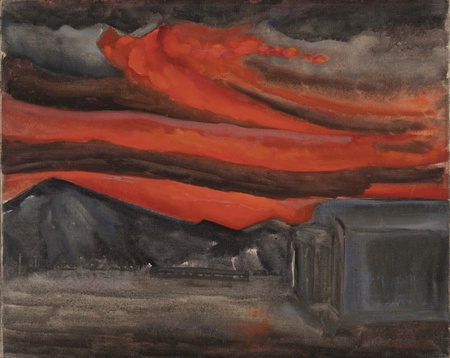
© 2023 Kristopher Kato




